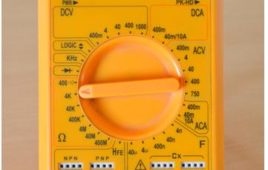Step 1: Choose any active alternating current socket. Fig. 1: Image of an AC socket Note: Make sure that the socket is not turned ON. Step 2: Turn the multimeter knob to the ACV or AC Voltage section: Fig. 2: Image of ACV Section of Multimeter To ensure safe operation make sure that the knob is pointing…
Multimeter Tutorial: How to test Continuity
Continuity Test is a method to check current flow across any metallic path. Through this test, any unwanted circuit breaks or shorted connections can be put to verification. Continuity can be tested between any two circuit connections. Apparatus: Multimeter, connecting probes, circuit board. Step 1: Take the circuit board of which you want to test…
Multimeter Tutorial: How to Measure DC Voltage and Current
Fig. 1: Image of an LED circuit on breadboard Image above shows a simple circuit that glows an LED when connected to power supply.. Connecting LED directly to the power supply will damage it, hence aresistance of suitable value must be connected in series for its proper operation. Following the standard color convention,red wire serves as…
Multimeter Tutorial: How to Test and Measure Resistance
Step 1: How to Use Multimeter Fig. 1: Image of a multimeter As its name suggests, a multimeter measures various circuit parameters such as resistance, voltage, current, and capacitance. More precision over multimeter readings can be achieved by using a digital output.Measurements of different ranges are marked on the DMM. These are the maximum values of…
Multimeter Tutorial: How to Test a Transistor
This tutorial will detail with testing PNP and NPN configured transistors using a multimeter. After reading this, you will be able to find out configuration of the device as well as find out its collector, emitter and base. Fig. 1: Image of a transistor Step 1:Transistor Function on Multimeter. Fig. 2: Image showing Transistor function region in…
Multimeter Tutorial: How to Test LED
Step 1: Understanding the component Fig. 1: Image of an LED Light emitting diode (LED)is a small component used in almost every electronic device. Led has 2 terminals or legs. The bigger leg is the anode or positive terminal and shorter leg is cathode or negative terminal. But this method of identifying the leads will not…
Multimeter Tutorial: How to Test a Diode
Step 1: Understanding Diode Fig. 1: Image of a Diode Diode has two terminals Anode (+) and Cathode (-). Terminals can be identified by the shaded portion at the end of the diode. Terminal near the shaded portion is Cathode (-) and other one is anode (+). Diode can be tested with the help of Diode…







